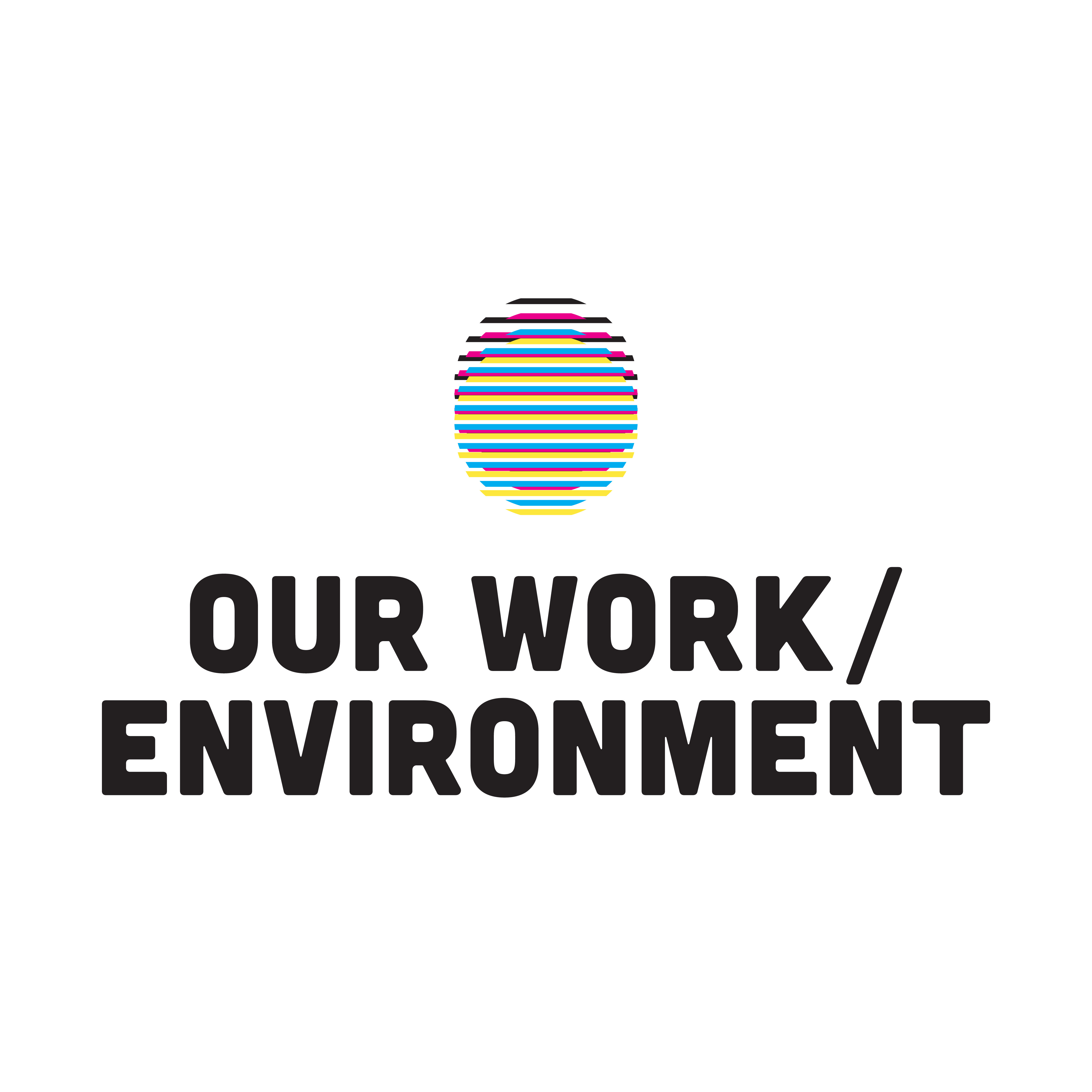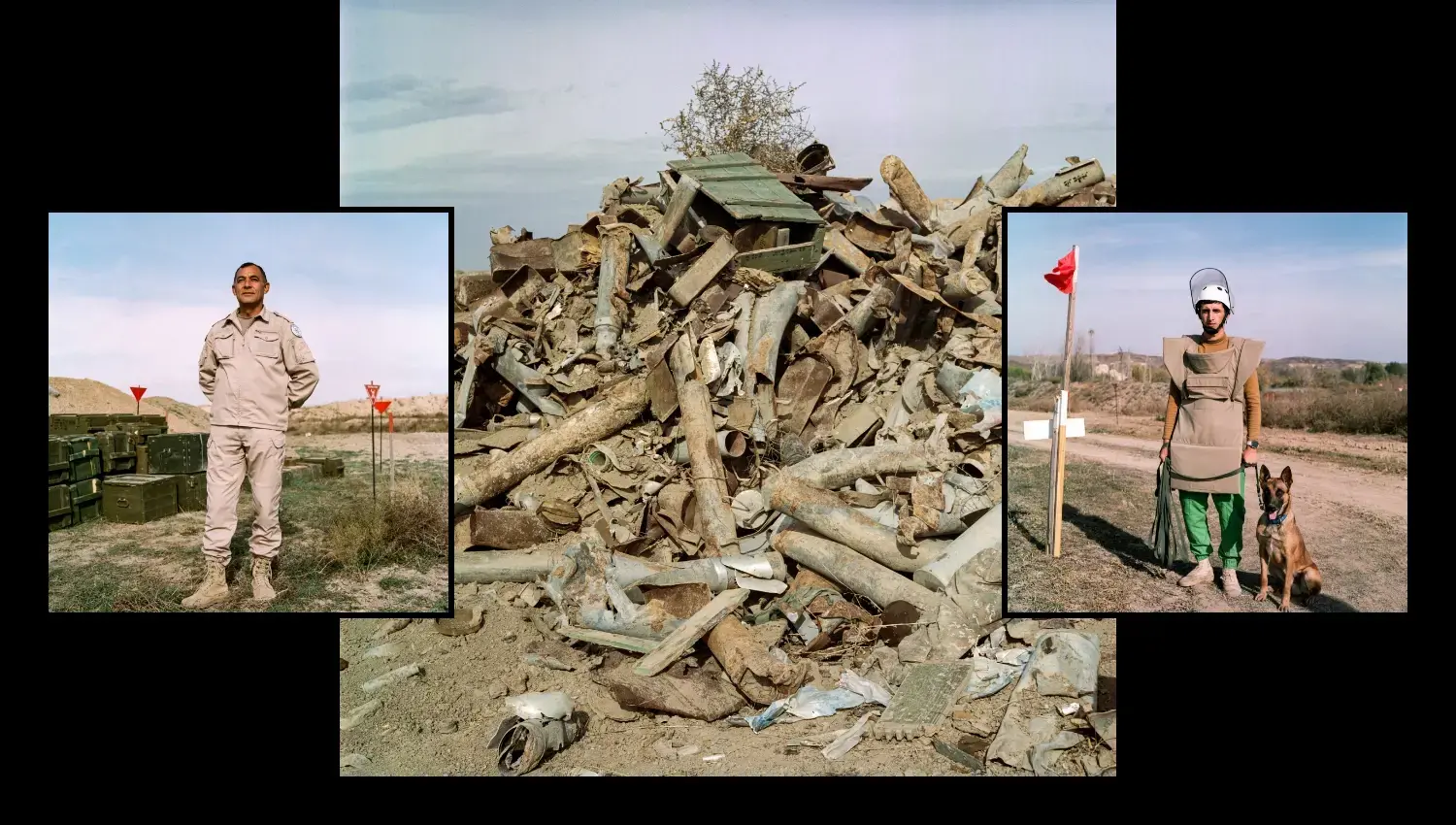
A contested environmental legacy looms over three decades of conflict.
AGDAM, Azerbaijan—In a clearing between overgrown grasses, Khalid Zulfugarov opens a stack of wooden crates, each filled with bright chunks of metal that glint in the winter sun. There are shells, anti-tank mines, and cluster bombs with tail fins. Nearby, next to a crater blown in the earth, a 20-liter water jug is filled with thousands of bullet casings, piled together like spare change, the collected relics of a conflict that has ravaged this land for 30 years.
Zulfugarov, the head of an Azerbaijani mine disposal team, is picking through his contaminated homeland, sifting through the soil with sniffer dogs and metal detectors to find each tiny, potentially deadly fragment. As he does so, his memories of Karabakh rush back.
“This is where I was born. I studied here; I fought with my friends,” he says.

As a nonprofit journalism organization, we depend on your support to fund more than 170 reporting projects every year on critical global and local issues. Donate any amount today to become a Pulitzer Center Champion and receive exclusive benefits!
His ancestral village is Nuzgar, which is located 50 miles south of Agdam, the area that he is currently clearing. It was once a bucolic settlement on the fertile lowlands of the southern Caucasus, mostly home to farmers who tended the rich, arable land. During Soviet times, it was part of the Nagorno-Karabakh oblast, home to ethnic Armenians and Azeris such as Zulfugarov, as well as the vineyards that produced the Soviet Union’s best-known cheap wine.
But when communism collapsed, so did the peace in Karabakh. Newly independent Armenia and Azerbaijan fought over the territory. Neighbors became enemies, and as Armenian paramilitaries gained control, Karabakh’s entire population of 700,000 Azeris fled.
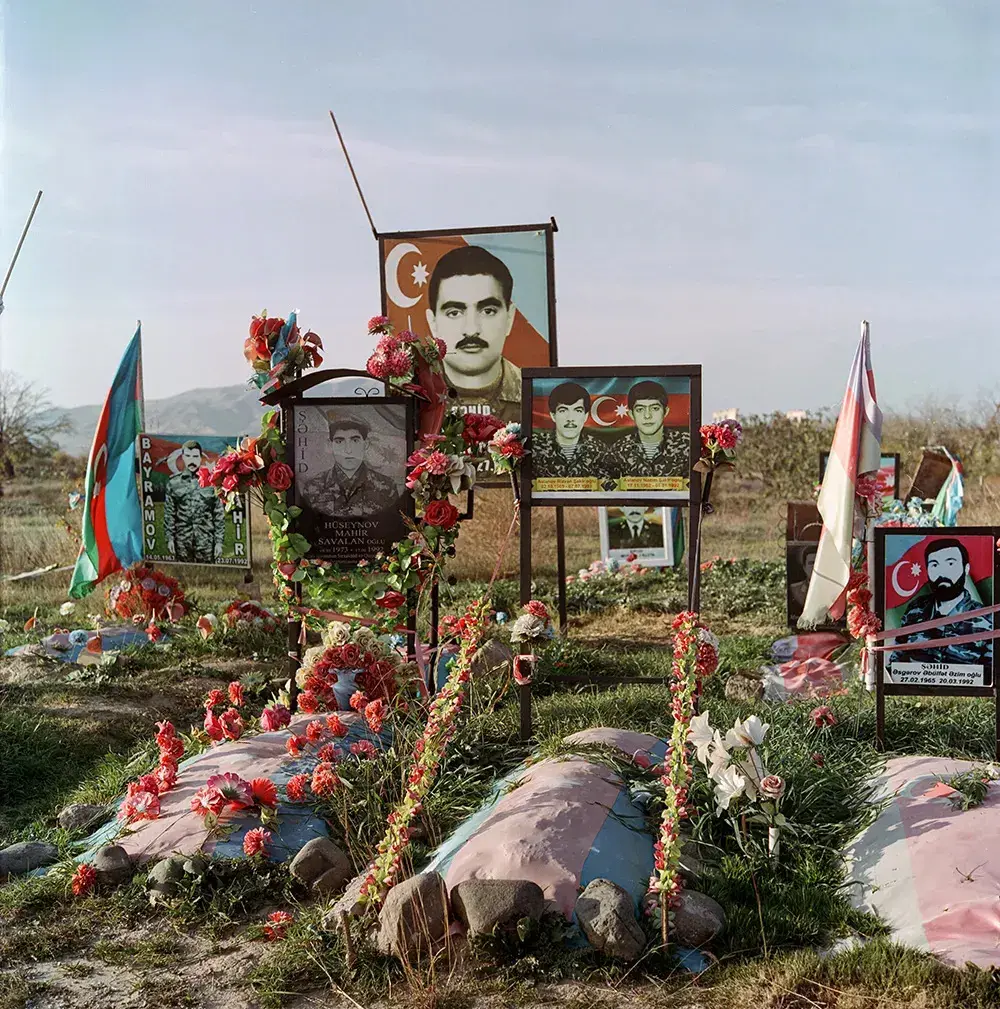
For the next three decades, Nagorno-Karabakh was governed by an ethnic Armenian administration as the Republic of Artsakh, an unrecognized country. Its shrunken, monoethnic population lived up on the mountains at its heart. Down on the plains, the abandoned Azeri towns and villages were looted and closed off to the world, becoming a buffer zone between Artsakh and Azerbaijan. A de facto 185-mile border was carved into the landscape with berms, barbed wire, and land mines. What was once vineyards became a barren no-man’s land.
In 1993, Zulfugarov, then a 19-year-old Azerbaijani conscript, fled Karabakh to Azerbaijan proper. There, he worked in construction before joining the national demining agency. For the past three years, he has been clearing the land just miles away from his home village of Nuzgar, yet he is still unable to return.
In 2020, after 26 years of relatively frozen conflict, Karabakh’s war reignited. Azerbaijan had turned into a gas-rich autocracy, and grievances over its loss of Karabakh had become central to its national story. Baku wagered that the geopolitical timing was right, and over the first nine months of 2020, it pumped up its military arsenal with $123 million of Turkish-made defense and aviation equipment. On Sept. 27, Baku launched a surprise offensive and recaptured the lowlands. Three years later, it launched a second offensive and seized the main city, Stepanakert, too. Nearly all of the region’s entire ethnically Armenian population fled, just as the Azeris had three decades earlier.
On Jan. 1 of this year, the Republic of Artsakh officially ceased to exist. The land that was once Nagorno-Karabakh is now fully controlled by Azerbaijan.
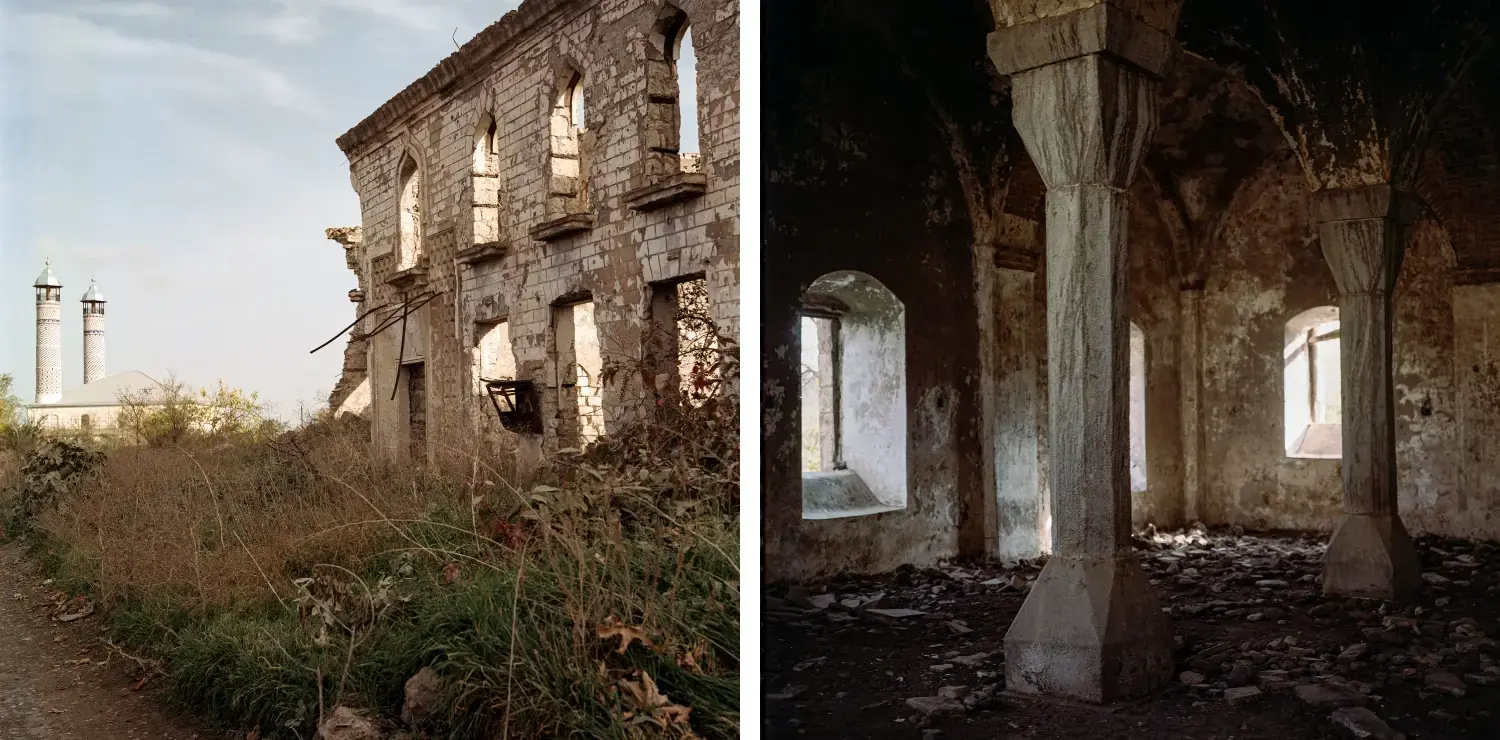
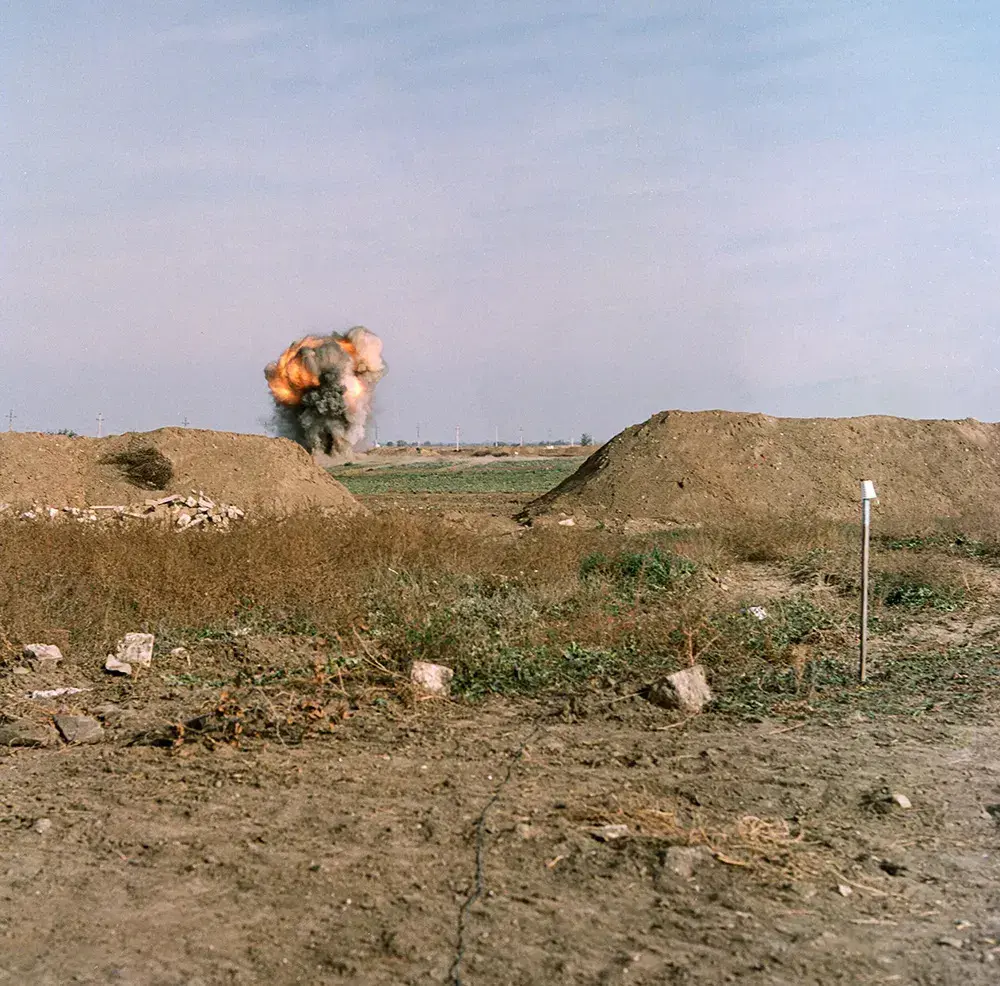
War and occupation have stripped the landscape of life and color; the ruins of Azeri villages are now the same beige-grey as the scrubby undergrowth, the once-fertile soil riddled with metal from tanks, shells, and bullets. The pomegranate trees are among the few things that survived from the old times, bearing yearly fruit that hangs unpicked until it bursts blood-red.
The area remains closed to the public, but Foreign Policy was granted access by the Azerbaijani government. (We were not given permission to visit some areas we requested, and Stepanakert is currently closed to foreign media.) We spent five days in the region, being escorted through a huge reconstruction project unfolding behind a curtain of checkpoints: demining sites, new villages, roads and airports, and reforestation projects, all being readied for former residents to return.
The fighting in Karabakh is now over, and the Republic of Artsakh is no more. But a new conflict—this time, centered on the region’s landscape and the scars that war has inflicted on it—is now underway.
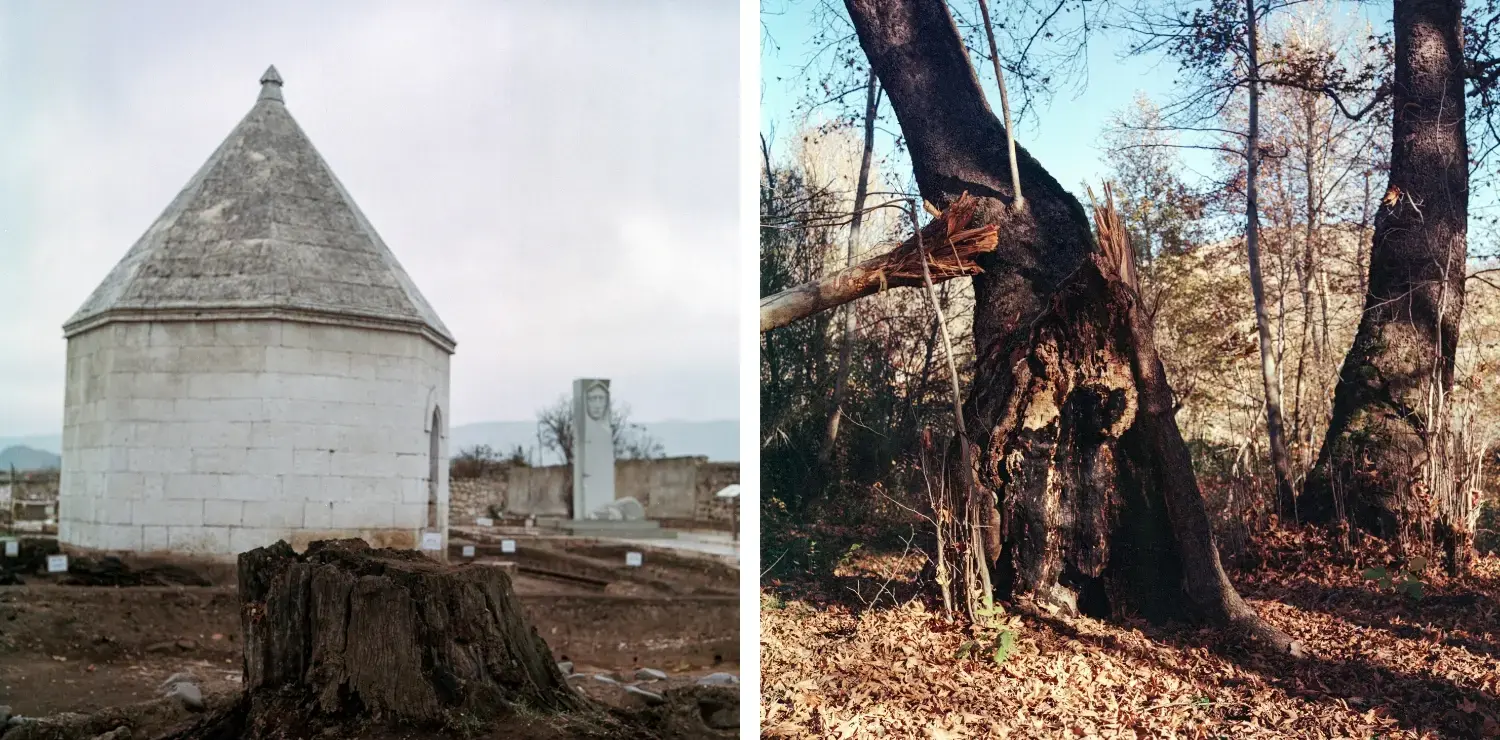
Since the beginning, nature has been both a victim to and a weapon of Karabakh’s conflict.
Nagorno-Karabakh is the water source for much of the southern Caucasus. Tributaries of the major Aras, Kura, and Tatar rivers run through the region’s mountains and down to the plains of Azerbaijan. The Soviet-built Sarsang reservoir—once the biggest in the region—fell under the control of Artsakh in 1993. In September 2013, Baku filed a case with the Council of Europe, complaining that Artsakh was misusing Sarsang and intentionally depriving 400,000 people in Azerbaijan’s border regions of water. Baku’s case succeeded: In January 2016, the council called for Armenian forces to withdraw from the area around Sarsang to allow international teams to assess and repair critical infrastructure.
When Karabakh’s hot war reignited in September 2020, the landscape quickly became a focus of misinformation. Huge forest fires broke out on the front lines in the far north and southwest of the territory and close to Stepanakert. Fires are common in conflict, but these blazes were immediately weaponized. Azeri social media accounts accused Armenians of torching the trees as they fled the advancing Azerbaijani army. Armenian accounts accused Azerbaijani forces of starting the fires with incendiary weapons to provide cover for their offensive.
“Nowhere else has environmental misinformation been used at this level. It’s just off the scale,” said Eoghan Darbyshire, a researcher at the U.K.-based Conflict and Environment Observatory. He analyzed open-source satellite imagery and climate data and found that while the fires were almost certainly related to the conflict, proving who had started them and how was far stickier than the absolutist social media posts suggested.
By November 2020, Azerbaijan had recaptured the Karabakh plains, and Artsakh conceded the loss. Stepanakert remained in Armenian hands, while the rest of the territory was left with Azerbaijan. Russian and Turkish peacekeepers monitored the cease-fire. Although combat was over, the environmental dispute only intensified.
Following the cease-fire, Azeris began trickling back to the Karabakh plains to visit their homes for the first time in three decades, only to realize that the whole area had changed. The lush hilltop forests had been hacked away, and the water in the once-clear streams smelled putrid. Agdam’s ancient Oriental plane trees, which had been protected as state monuments since Soviet times, had been felled, and their roots were scorched. Azerbaijani officials say that Artsakh’s government caused the destruction—through some combination of pillaging Karabakh’s hardwood forests, opening a gold mine that leached pollutants into the water, and simple vandalism.
In March 2022, Azerbaijan’s government invited the United Nations Environment Program (UNEP) to assess the Karabakh plains. The UNEP documented 2,000-year-old trees felled, once-cultivated farmland abandoned, 52 new quarries or mines opened under Armenian administration, and extremely high levels of heavy metals in the Okhchuchay River, which flows from Karabakh to Azerbaijan.
The report that the program produced was meant to be for internal use only, but the Azerbaijani government released it publicly, using it as the basis for a new legal challenge. In January 2023, Azerbaijan announced that it would be filing another case against Armenia with the Council of Europe, this time alleging breaches of the Bern Convention, which governs the conservation of European natural habitats and wildlife.
Meanwhile, in December 2022, Azerbaijani eco-activists began blockading Stepanakert with pickets on the Lachin Corridor, the sole road running from the rump state of Artsakh to Armenia proper. Their complaints were the same as those made by the government: that Artsakh was illegally destroying Karabakh’s habitats. Baku said the protests were independently organized, and media organizations connected to the Azerbaijani state invited journalists in to report. Baku also engaged public relations firms to spread the news of the Bern arbitration.
In April 2023, Azerbaijan built a permanent military checkpoint on Lachin, cutting off all traffic in and out of Stepanakert—as well as the city’s gas and electricity cables. For nine months, Artsakh relied solely on the Sarsang dam to generate electricity. As a result, the reservoir, which feeds springs to the Tatar River and supports migratory birds, dropped to critically low levels.
Foreign Policy requested but was not granted access to the reservoir, but photographs shared with FP show the reservoir’s decline over the course of 2023. Steppes of brown banks drop sharply to the new water level, some 20 meters (65 feet) below what it was before the blockade. The ground left behind is sticky and infertile.
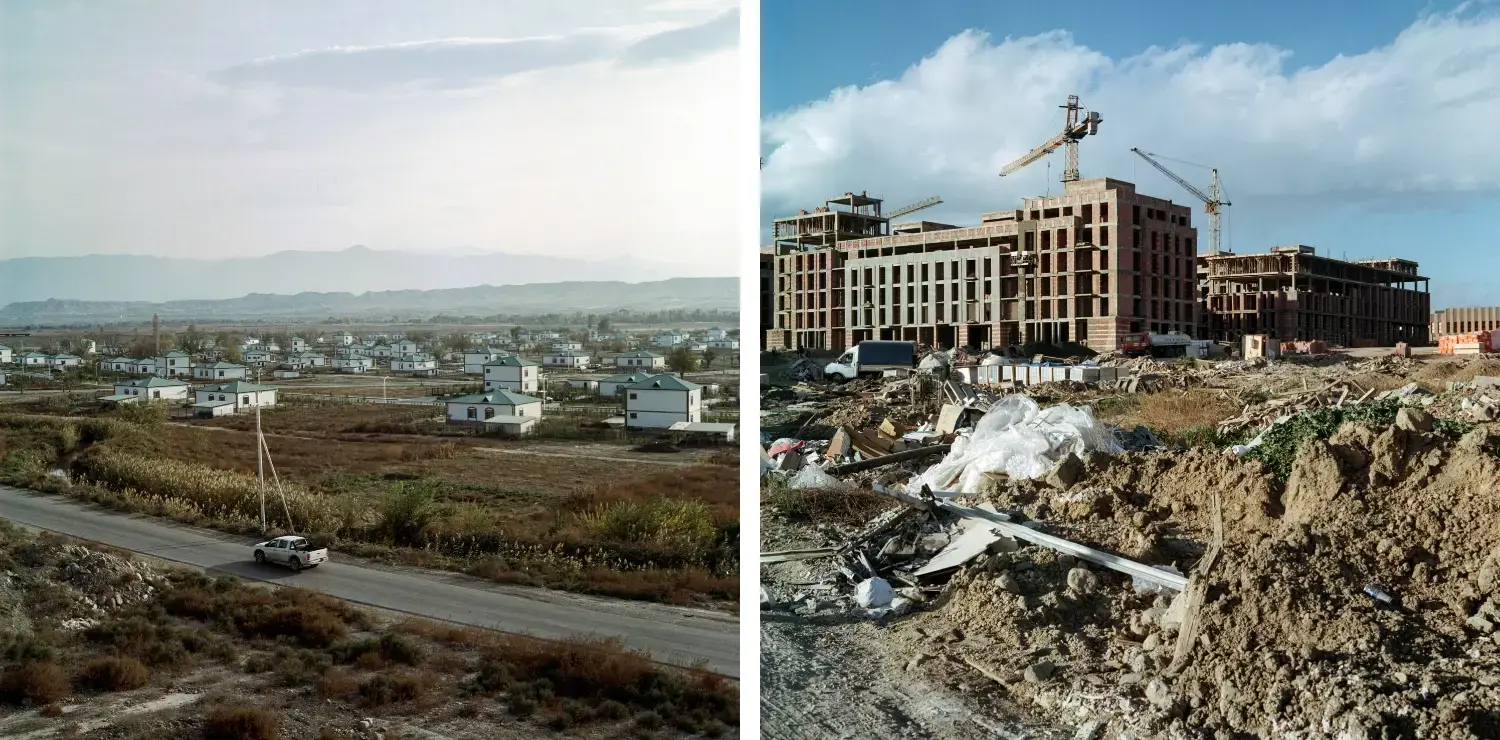
Karabakh’s environment is now a cornerstone of Azerbaijan’s image campaign as it pushes to reconstruct and repopulate the region as quickly as possible. At the COP28 U.N. climate conference in Dubai in November 2023, Baku showcased its plans for the reconstruction of Karabakh from a display in its wood-trimmed pavilion, decorated with pictures of tranquil lakes and mountains.
Azerbaijani President Ilham Aliyev has promised that new hydroelectric dams in the region will be generating 270 megawatts by the end of this year, and that a solar farm capable of generating 240 megawatts will soon begin construction. New houses are being fitted with solar panels, and dams and climate-monitoring stations are undergoing restoration. Huge replantation projects are already underway to regrow lost forests, and native species, such as the Eurasian gazelle, are being reintroduced after decades of localized extinction. Baku has pledged to prioritize environmental and climate concerns during this process and has committed to a net-zero carbon emissions target in Karabakh by 2050, when the reconstruction is expected to be completed. Eventually, Aliyev says, Karabakh will turn Azerbaijan into an exporter of green energy.
“The great return will be a green return. We want to focus on the future, what we can improve,” Umayra Taghiyeva, Azerbaijan’s deputy minister for ecology and natural resources, told Foreign Policy.
In reality, Azerbaijan’s environmental imperatives are clashing with political and economic ones. On the ground, the region is mostly a construction site as new villages and towns, thousands of miles of roads and railways, and even two new airports are being built from scratch. Convoys of diggers chug through the ever-expanding arteries of this newly disturbed land, kicking up dust and petrol fumes.
In Agdam, they are starting to claw down the pomegranate trees to make way for the newly laid-out city. According to UNEP reports, waste from the demolition of old buildings is being poured into landfills, and the construction of new roads is destroying even more of Karabakh’s forests.
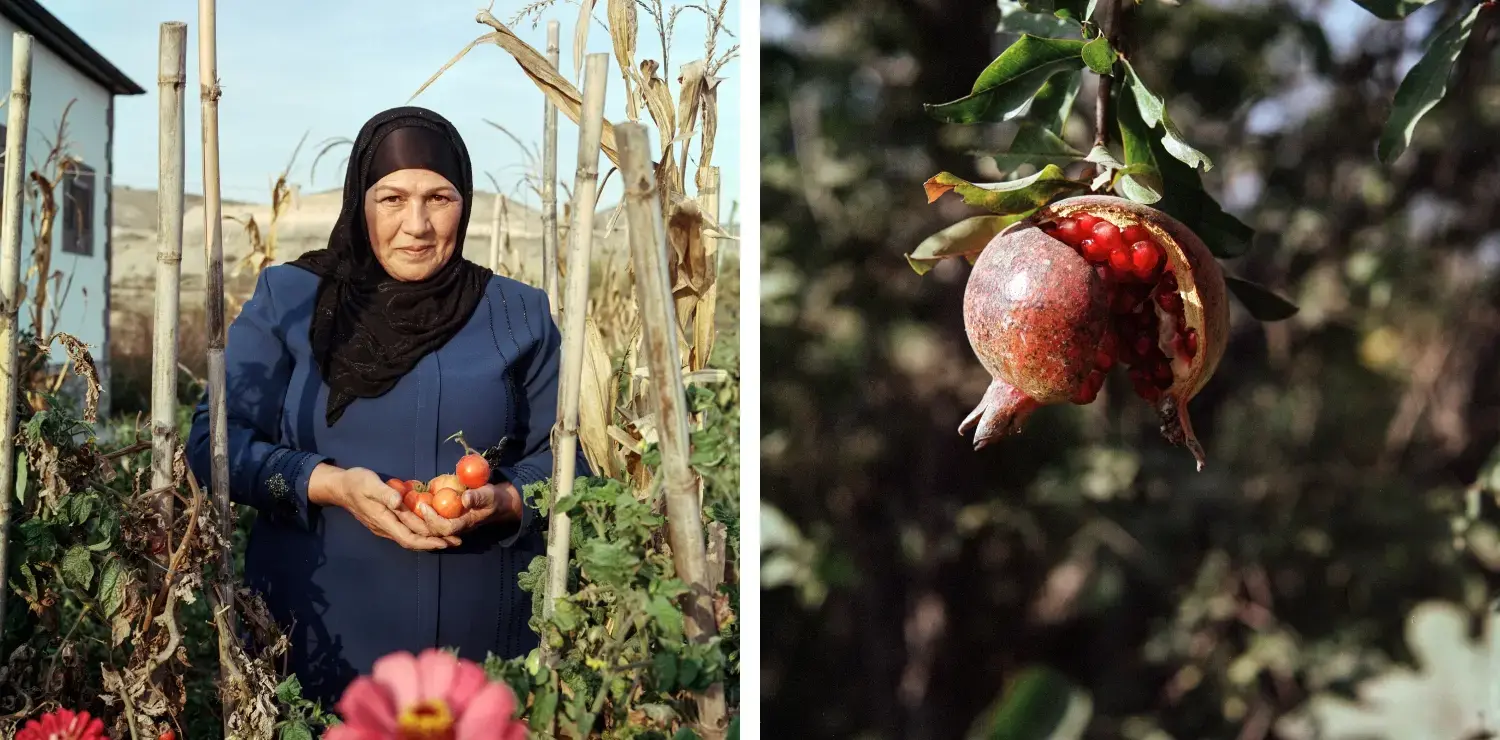
Much of what has been built already is Potemkin-like. Brand-new buildings, conference halls, and village squares are silent and underused—a jarring sight against the ruins of the old settlements. The first batch of former residents who have returned and resettled have been willing to withstand a strange isolation for the prize of coming home. Their rebuilt villages lie at the end of the ruler-straight new highways, about a four hours’ drive from Baku. The populations are still tiny—in the thousands overall. Most places, however, are still mined; independent experts and the Azerbaijani government have estimated that more than 1 million mines have been laid in the area. As of April 2023, only 7 percent of the contaminated land had been cleared.
The only commercial flights into the new airports thus far are transporting delegations from Turkey—one of Aliyev’s biggest allies—whose constructors have won major contracts in Karabakh. The construction company Kalyon, which is controlled by in-laws of Turkish President Recep Tayyip Erdogan, is building roads, while another in-law has won the contract to build an agropark—part of Baku’s ambitions to turn the once-agricultural region into a high-tech farming hub.
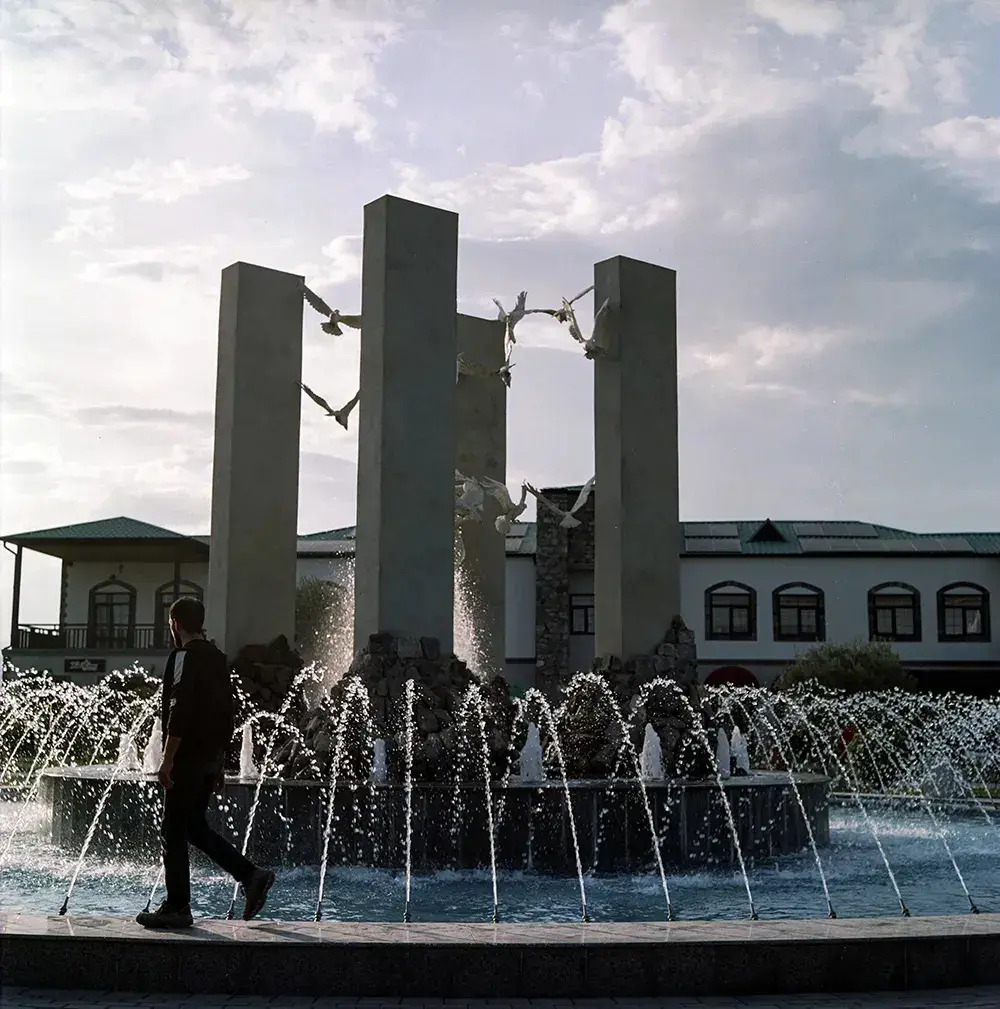
Baku will ramp up its green public relations drive later this year when it hosts COP29—a bid that it won with Armenian backing. Unsurprisingly, given that Azerbaijan is also a major petrochemicals producer, some see this public commitment to sustainability as little more than lip service. Its ambitious promises in Karabakh will undoubtedly be scrutinized under the spotlight.
“It is one of the more powerful examples of state greenwashing. In a different world they could create a new national park, and create employment through environmental projects and tourism,” Darbyshire said.
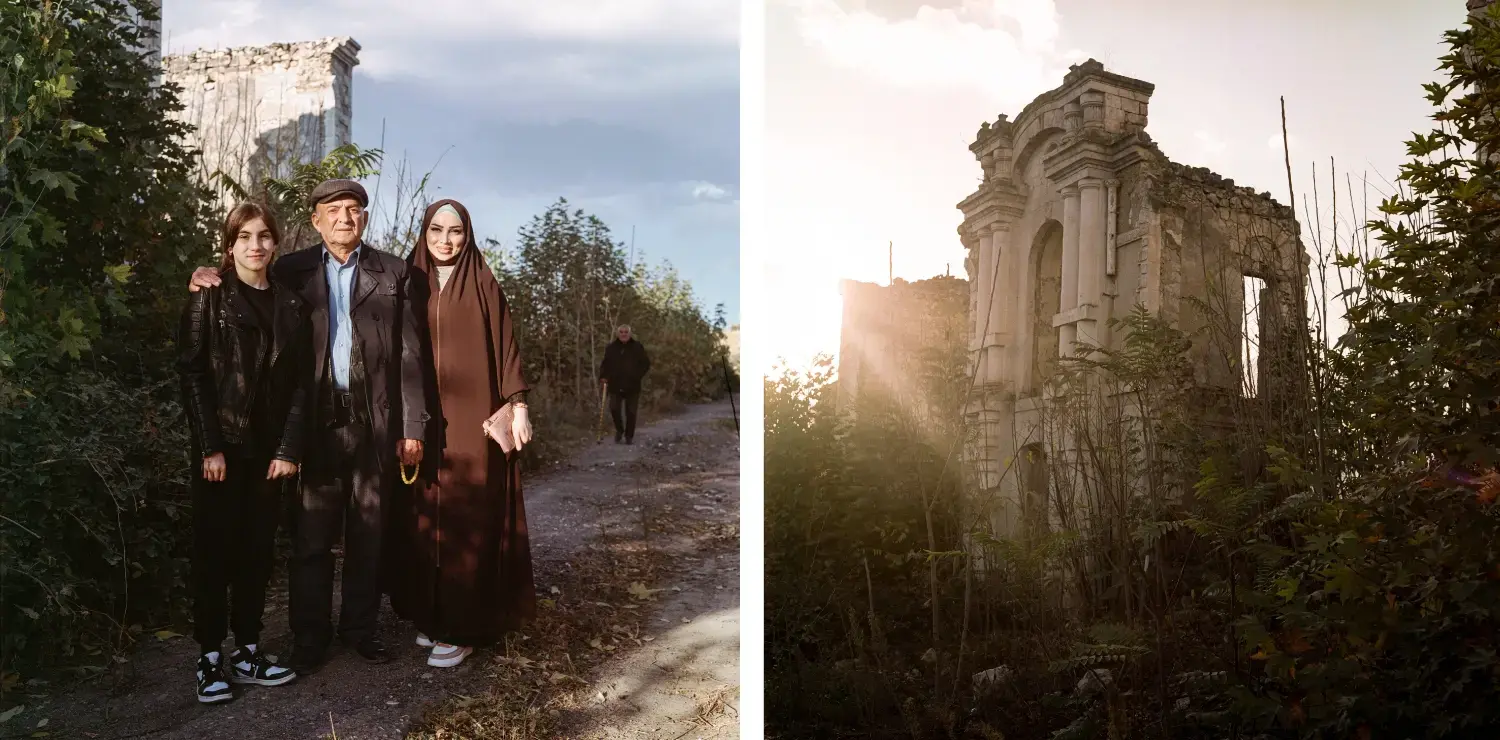
Aliyev has gained popularity from his victory in Karabakh and its reconstruction; many of the region’s newly returned residents proudly showed Foreign Policy their photos with the president. Today, however, there is almost no political opposition left in Azerbaijan, and critics of the war tend to live abroad in exile. But in less guarded moments, many Azeris working in Karabakh raise an amused eyebrow at the stark differences between the old land and the new.
Demining is expected to take decades, and full reconstruction—let alone rehabilitating the landscape—will take longer still. By the time the region is a fully functioning part of Azerbaijan, it will likely be unrecognizable from the idyllic place where Zulfugarov grew up. Reconstruction is yet to start in Nuzgar, which is still inaccessible, but he is certain that he will move back someday.
“I don’t think of what happened here, I think of what it will become,” he says, gesturing to the diggers working on the horizon. “In five or 10 years, this can be one of the most beautiful places.”
Correction, Feb. 28, 2024: This article has been updated to amend inaccurate dates and descriptions in two photo captions.









